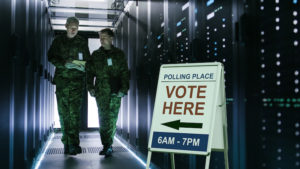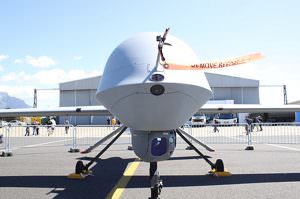The U.S. Government Is Metamorphosing Into the Borg
Describing the U.S. government is becoming increasingly complicated: “petro–imperial," "coal–fired," "plutocratic," "oligarchic," "inverted totalitarian," "fascist," "propagandistic," "Big Brother.” Things are beginning to simplify though. Soon you’ll be able to refer to the institution with a single idea from "Star Trek": the Borg.
By Subhankar Banerjee, ClimateStoryTellersThis piece first appeared at ClimateStoryTellers.Any intelligent fool can make things bigger, more complex, and more violent. It takes a touch of genius—and a lot of courage—to move in the opposite direction
—E. F. Schumacher
When I moved to Seattle in 1996, I thought I knew how to order a cup of coffee: “I’ll have a cup of coffee please.” Soon I realized it was more complicated: “I’ll have a Venti soy dolce latte, topped with sprinkled cinnamon and caramel drawing on whip cream, with coffee on the side please.” Talking about the U.S. government is increasingly becoming as challenging as ordering coffee in Seattle: “Petro–imperial, coal–fired, plutocratic, oligarchic, inverted totalitarian, fascist, propagandist, Big Brother, with democracy on the side.” Things are beginning to simplify though. Soon you’ll be able to refer to the U.S. government with a single idea from the science fiction universe of Star Trek: the Borg.
Two recent news stories reveal that Homo sapiens aren’t always loyal to a tyrannical regime. Edward Snowden opened a valve that allowed crude secrets to flow out of NSA’s pipelines—to benefit humanity. And in protest of America’s “dirty wars,” Brandon Toy publicly resigned last week from his job at the US Defense contractor General Dynamics. In his resignation letter, published on Common Dreams, Toy wrote: “I have always believed that if every foot soldier threw down his rifle war would end. I hereby throw mine down.”
What if the U.S. military were to replace not–to–be–trusted Homo sapiens with completely trustworthy Robo sapiens?
On 11 July 2013, the US Defense Advanced Research Projects Agency (DARPA) unveiled the “Atlas” humanoid robot. Before I go on, take a look at the skeletal structure of Atlas here. Now, in your mind’s eye put some smooth metal over the skeleton, and take a look at a Star Trek Borg here (stationed at the Hollywood Entertainment Museum). Do you not think they are siblings, or more appropriately two members of the Borg collective? They are—because both are creations of the human mind.
Inspired by the Fukushima nuclear catastrophe, the DARPA Robotics Challenge (DRC) was launched last October. Nine months later, Atlas, a six–foot tall, 330–pound baby was born (developed by Boston Dynamics with DARPA funding). Atlas “May Foreshadow Age of ‘Robo Sapiens’” is how the New York Times headlined the news. The DRC program manager Gill Pratt gave a rather emotional justification for his program with these words:
Two weeks ago 19 brave fire fighters lost their lives. A number of us who are in the robotics field see these events in the news, and the thing that touches us very deeply is a single kind of feeling which is, can’t we do better? … I think the answer is yes.
The MIT Technology Review noted that “Atlas is designed to eventually take on some of the most dangerous and high–stakes jobs imaginable, such as tending to a nuclear reactor during a meltdown, shutting off a deep–water oil spill, or helping to put out a raging wildfire.” But Atlas isn’t there yet. “We’re talking about a robot roughly on par with the motile competence of a one–year–old child,” according to DARPA. In time though, Atlas and its various siblings that DARPA is creating now, will grow up.
DARPA insists that Atlas is not being designed for adversarial military tasks, but for humanitarian reasons—to aid rescue efforts during future natural and human–made disasters. Not everyone is convinced. “The US military has shown off what may become the soldier of the future: a hulking robot that would easily look at home in Hollywood’s Terminator franchise or an Isaac Asimov novel,” the Australian reported. And Michael Allen opined about Atlas in Opposing Views, “DARPA is famous for trying to create new military weapons, so that could be a possibility as well.” The latter is a good hint worth exploring.
In 1968, when I was one year old, if I had told you that the U.S. government would someday use the Internet to spy on its citizens and people of the world, you would have said: “That’s a toddler talking.” As it turns out, that year, the Advanced Research Projects Agency (ARPA, later renamed DARPA) of the U.S. Department of Defense approved a plan to develop what would become the ARPANET—the progenitor of what we now call the Internet. The Internet’s gene is through and through military. So it should come as no surprise to anyone that the Obama administration has figured out a way to spy on all forms of global Internet communications. After Atlas grows up, the “homeland security, anti–terrorism and warfare will never be the same,” the Examiner.com noted.
When the U.S. government assures the public that a particular military program is being developed for humanitarian reasons, should we believe? History tells us we must not.In 1961 the U.S. government initiated Project Plowshare to develop “techniques to use nuclear explosives for peaceful construction purposes” to benefit humanity. Due to public opposition the program was terminated in 1977. One of the first proposed Plowshare nuclear experiments was Project Chariot. In 1958 Edward Teller, father of the hydrogen bomb, went to Alaska to unveil the project: a plan to blast six large thermonuclear bombs at Point Thompson, between two Iñupiat villages (Point Hope and Kivalina) in the Arctic, to carve a new harbor on the Chukchi Sea coast. Because of the courageous and creative efforts by the Iñupiat people of Point Hope, two University of Alaska biologists William Pruitt and Leslie Viereck, who were fired for speaking out against the plan (and three decades later were honored by the Alaska State Legislature for the same act), and a handful of conservationists, Project Chariot was stopped, preventing the U.S. government “from inflicting a catastrophe worse than Chernobyl on its own land and people,” as was noted in historian Dan O’Neill’s groundbreaking book, The Firecracker Boys. While the larger experiment was stopped, Point Hope–based Iñupiat conservationist and Goldman Prize winner Caroline Cannon wrote in her testimony in the anthology, Arctic Voices: Resistance at the Tipping Point (which I edited):
Even though the bombs were not detonated, the area is still radioactively contaminated by an experiment to estimate the effect that radioactive material would have on water sources. Materials from a 1962 nuclear explosion at the Nevada Test Site were transported to our homelands in August 1962, used in several experiments, and then buried. … Many of our young people have died of cancer. My own daughter was diagnosed with leukemia in August of 2005, which is known to be linked to exposure to radiation. To see young people die in big numbers like that is alarming.
I wrote in a recent article that the human mind is like a boomerang. Its ingenuity and the deviousness are two sides of the same coin. In the future, no one should be surprised if Atlases get deployed on the streets to crush popular resistances against American tyranny, both at home and abroad.
We don’t need robots. Instead, we need to “move in the opposite direction” that Schumacher suggested. We need to care for each other and give space to nonhuman biotic communities to thrive on this Earth.
Gill Pratt’s question “can’t we do better?” could be answered more honestly not by developing “Robo Sapiens” that could offer help during disasters, but among other things, by stopping Canada and the US from becoming rogue, reckless petro-states that create dangerous climate change with many more deaths from fires (like the one in Arizona that Pratt was lamenting).
Capitalism thrives not by addressing the causes of injuries, but by constantly producing new Band–Aids for sale. Atlas is more than capitalism though. It is also about militarism. We would do well to pay attention and challenge its construction, rather than wake up later and see massive destruction.
Equipped with Atlases on the ground, drones in the sky, and realtime global surveillance, the U.S. government will soon be ready to say: “Resistance is futile.”
What once lay only the realm of science fiction is increasingly becoming reality, and we have to contend with it. We would do well to pay attention to journalist Chris Hedges’ premonition that “Revolt Is All We Have Left.”
Your support matters…Independent journalism is under threat and overshadowed by heavily funded mainstream media.
You can help level the playing field. Become a member.
Your tax-deductible contribution keeps us digging beneath the headlines to give you thought-provoking, investigative reporting and analysis that unearths what's really happening- without compromise.
Give today to support our courageous, independent journalists.





You need to be a supporter to comment.
There are currently no responses to this article.
Be the first to respond.